This is my tenth A to Z Challenge. My first was in 2013, but I missed 2021. This April I am going through the alphabet using snippets about my family through the generations.

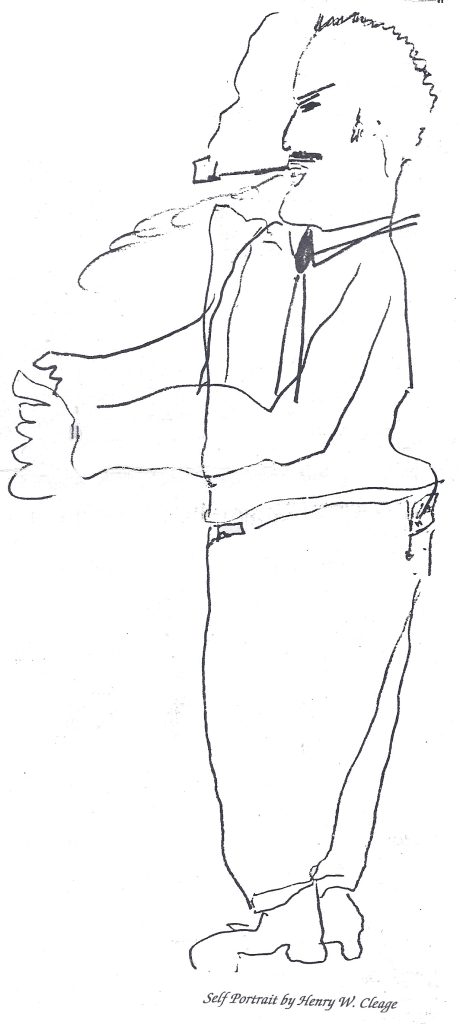
Click article to enlarge for reading.

This is my tenth A to Z Challenge. My first was in 2013, but I missed 2021. This April I am going through the alphabet using snippets about my family through the generations.
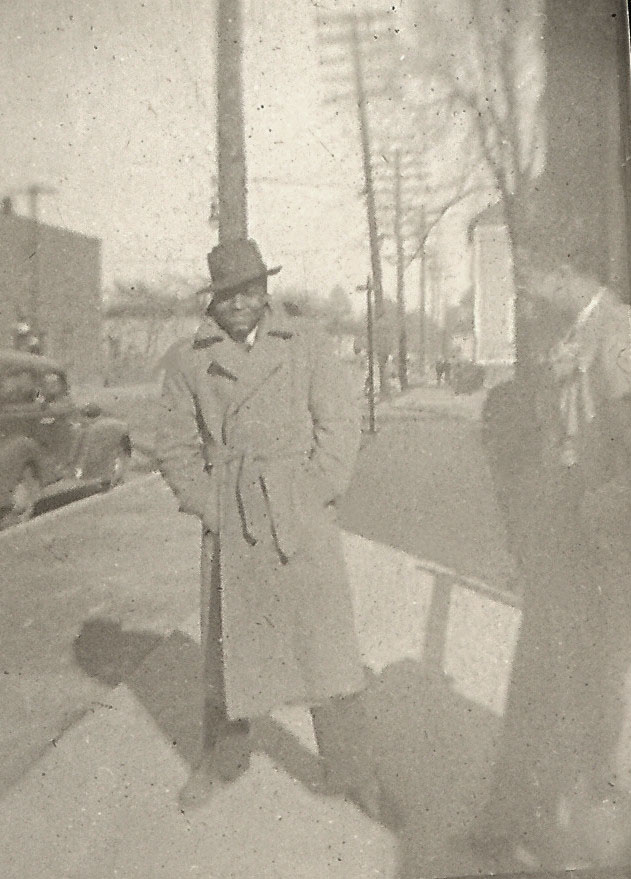

Oscar Hand was born in Tuskegee, Alabama. He moved with his family to Detroit, Michigan after 1935. The family lived near to the Cleage family on Scotten and he became a lifelong family friend. Music was always very important to Mr. Hand and he studied and sang with the Robert N. Nolan Chorus for years. When I knew him he was the director of our church choir and I can still hear him singing in my mind. He had a very powerful baritone.
Oscar Hand, one of the founding members of the Shrine of the Black Madonna in Detroit. For many years he was the choir director at the Shrine of the Black Madonna in Detroit. In his later years he lost his sight due to glaucoma. Almost until the end, he still sang “Let Us Break Bread Together” now and then.
Mr. Hand was one of the founding members of the Freedom Now Party and ran for sheriff on that ticket in 1964. He was always active in the fight for civil rights, regularly picketing Sears and A & P during the 1960s, for jobs for black people. He was married to Frankie Warren Hand and they had one daughter. Oscar died at home on October 26, 1996.

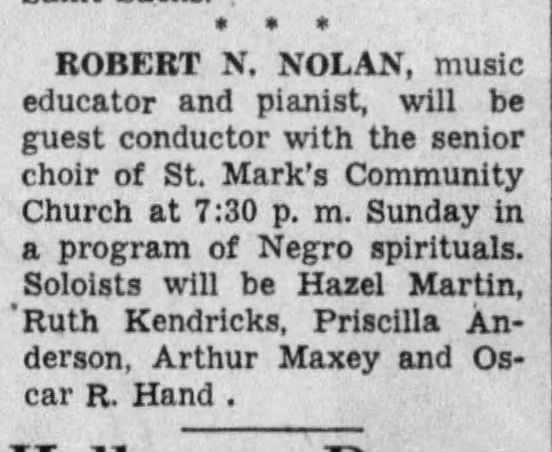

This is the song Oscar Hand sang in the play described above.

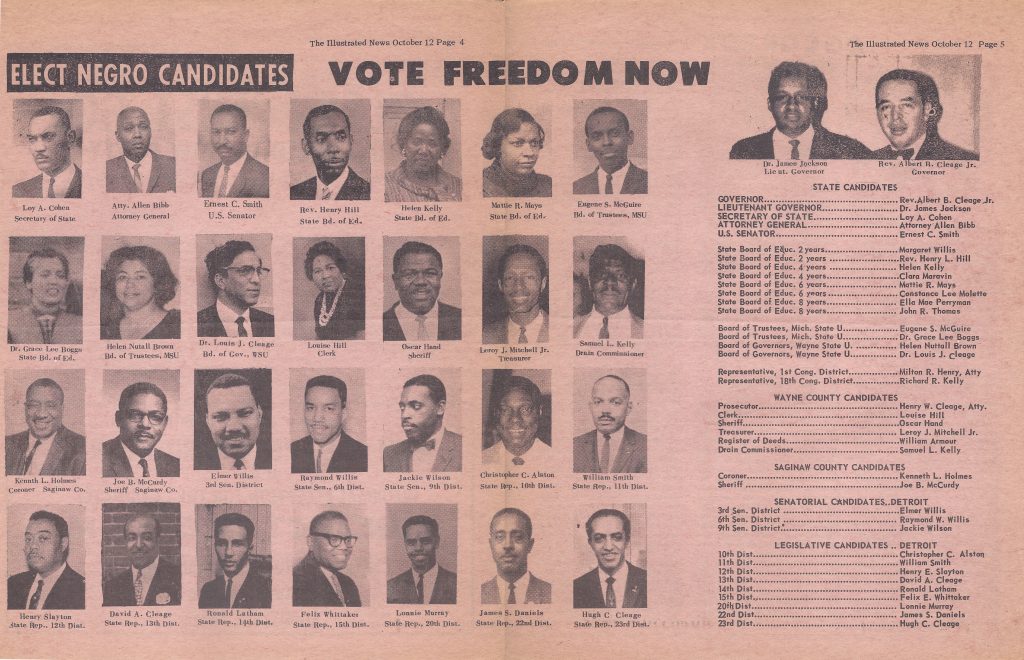
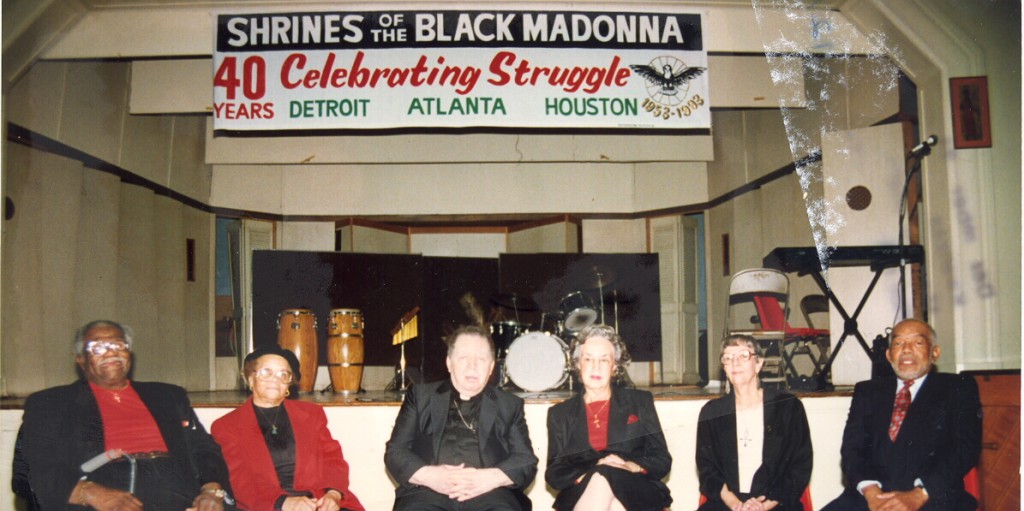

This is my tenth A to Z Challenge. My first was in 2013, but I missed 2021. This April I am going through the alphabet using snippets about my family through the generations.
When I was growing up in Detroit, my birthday was often celebrated at my grandparent’s house because it fell on August 30, during our school vacation. My grandmother, Nanny, would make my birthday cake. When we celebrated at home, my mother made one using Nanny’s recipe.
The recipe below was written on the back of a picture in the ‘frosting’ section of my mother’s falling apart cookbook.
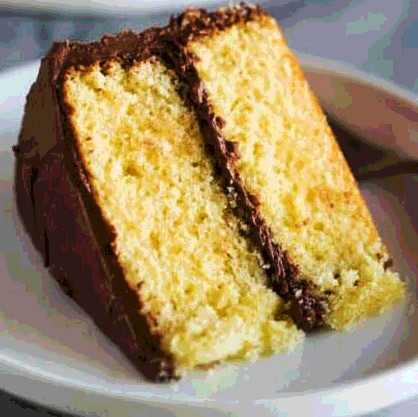
1 1/2 c. butter
2 c. sugar
3 c. cake flour, unsifted
4 large eggs
1 c. milk
3 t. baking powder
1/2 t. salt
1 t. lemon extract
1 t. vanilla “
1/2 t. nutmeg
Sift dry ingredients together. Proceed as usual.
Melt 2 or 4 sq. unsweetened chocolate and 3 Tb. butter over hot water.
Measure 1 lb. sifted confec(tioner). sugar, add 1/8 tsp. salt, 7 Tb. milk, and 1 tsp. vanilla. Blend. Add hot chocolate mixture and mix well. Let stand. Beat until of right consistency to spread on cake.
******
My mother’s memories of her mother.
Fannie Mae Turner Graham 1888-1974 Part 1
Fannie Mae Turner Graham 1888-1974 – Conclusion

This is my tenth A to Z Challenge. My first was in 2013, but I missed 2021. This April I am going through the alphabet using snippets about my family through the generations. On Saturdays I’ve combined my usual Sepia Saturday post with the letter of the day. A double challenge.
In 1945 my father, Rev. Albert B. Cleage Jr., became the pastor of St. John’s Congregational Church in Springfield, Massachusetts. He and my mother, Doris, arrived there at the beginning of October.
Camp Atwater was connected to the church. It is located in N. Brookfield, Massachusetts, 34.5 miles from St. John’s. In November they took a tour in the company of former pastor Dr. DeBerry and his wife. Below is a page from my father’s photo album. Comments were written by him. The camp is still functioning, although no longer connected to St. John’s. The Urban League now runs it.
“Camp Atwater is a cultural, educational, and recreational camp designed for the children of African American professionals. The camp, founded in 1921 by Dr. William De Berry, was located in North Brookfield, Massachusetts. Initially named St. John’s Camp, in 1926 the name was officially changed to Camp Atwater when Ms. Mary Atwater donated $25,000 with the stipulation that the camp’s name honor her late father, Dr. David Fisher, a well-known and distinguished physician in the town. The camp is the oldest American Camp Association (ACA) accredited African American owned and operated camp in the nation.”
Click for more information about Camp Atwater

This is my tenth A to Z Challenge. My first was in 2013, but I missed 2021. This April I am going through the alphabet using snippets about my family through the generations. I first published a version of this post ten years ago.
I was born with a head full of black hair that could be pulled up into a little top pony tail. It soon fell out leaving me practically bald with a bit of blond hair. It slowly grew in sandy and kinky like my father’s and grandfather’s rather than wavy/straight like my mother’s and grandmother’s.
From a letter written to her in-laws by my mother, March 18, 1947. I was six and a half months old:
Kris (with her 2 teeth) says any time for you all laughing at her bald head – I fear it’ll be covered all too soon with first one thing and then another.
Doris
When Pearl and I were little, my mother didn’t wash our hair often. Once every two weeks? Once a month? Not very often. She used Breck shampoo, put a little olive oil in the sink full of warm water and poured it over for the final rinse. After and between washings she’d part our hair and put “Three Flowers” grease on our scalp. I remember that sometimes, when I was in elementary school, she would roll it up on tissue curlers and let me wear it “down” for one day after she washed it. I enjoyed the change from braids but it wasn’t really “down”.
Aunt Abbie, my maternal great grandmother’s sister, lived with my grandparents. She assured my mother that is was all right that Pearl and I didn’t have “good” hair because we had blue eyes. She assured my Aunt Mary V. it was okay her daughter’s didn’t have light hair or eyes because they had “good” hair. The sister’s shook their heads about it.
When I was in sixth grade, a classmate asked me during art class if I had ever had my hair straightened. I had not. She hadn’t either. Ironically, that afternoon after school, my sister and I went to the beauty shop on 12th street near Calvert recommended by Aunt Mary V. and had our hair straightened for the first time. We got pony tails in back and a pony tail down the side. Going to the beauty shop always gave me a headache. I remember listening to my beautician talking to the other women about how hot it was and how her husband was going to have to sleep on the couch because it was too hot to be all up in the bed with another hot, sweaty body.
Eventually I stopped going to the beauty shop, although my sister continued for years. There were the beauty shop headaches, plus I started taking swimming in junior high and high school. Those horrible bathing caps didn’t keep out the water and my hair soon took back it’s natural form.
My mother still straightened my hair for special occasions. She heated the comb on the stove and there were the inevitable burns on the ears. Other times I wore my hair in what a classmate described as a “shredded wheat biscuit”. Sometimes I borrowed some of my father’s Murray’s Pomade and after brushing the stiff, yellowish stuff in, it did lay down and had small waves.
During the summers when I was about nine to thirteen, I spent a week at the mostly white Camp Talahi. Some of the girl campers would ask me “Why is your hair like that?”. At first I would say because that’s the way it grows. Eventually I just responded with “Why is your hair like that?” They would look puzzled.
My last semester of high school I didn’t take swimming and discovered that if I rolled my hair up on those hard, pink curlers I could wear it in a sort of curly side wave on the side and pull the back into a barrette for a low pony tail. Sometimes I even wore it down, somewhat like those hairdos in elementary school. Once Pearl and I braided it all up into lots and lots of little braids, which reminded us of the paintings in Egyptian tombs. We thought it was great, and I would have been way ahead of the times, however my father hated it and I never wore it like that anywhere.
While visiting Pearl at Howard for Thanksgiving of 1966, I let one of her roommates straighten my hair. My mother complimented me and thought it looked lovely. When I went down to Wayne, I met Jim in the Montieth Center. He was aghast that I had straightened my hair. I went into the restroom and washed it out in the sink and that was the last time I straightened my hair. I was 20.
At one point in our lives, Pearl and I complained to each other that we had inherited our father’s kinky hair instead of our mother’s wavy hair. We reasoned that boys were supposed to get their mother’s hair so if he had gotten his mother’s wavy hair, we would have inherited that because girls (in our theory) inherited their father’s hair. Later, when natural hair came in we were so glad we had the hair we did. We didn’t have to do anything but wash and wear to have afros.
The next summer, 1967, we had the Detroit riot/rebellion. My cousins, Janis and Greta, came to visit us for the first time from Athens, TN. They were the same age as Pearl and I. Somehow, it came up that I wanted to cut my hair for an afro. Greta volunteered to do it for me and she did. It was great! I loved it. The only scary part was going to my Grandmother Cleages for the first time afterwards. We were afraid she might say something negative or even mention it during mealtime prayers, but she didn’t. I was one of the first to wear an afro on Wayne’s campus. That fall, in Miriam’s Jeffries student apartment, I cut several people’s hair for their first afros. I remember Kathy Gamble was sad to see her long hair fall on the floor. I cut Martha Prescod’s and can’t remember who else. I hadn’t cut anybody’s hair before, although I cut my own when it got too long.
I wore an afro until about 1988 when I decided to let my hair grow out and see what happened. I let it grow until 2004 or so when I cut it all off again and kept it cut until 2014 when I decided to let it grow out. It was more trouble to trim it than it would be to grow it out and have it longer. Lately a lot comes out when I comb it. Luckily I started with a LOT of hair. What’s left grows faster and strangely straighter.

This is my tenth A to Z Challenge. My first was in 2013, but I missed 2021. This April I am going through the alphabet using snippets about my family through the generations.
The only thing I ever knitted was a pale blue very long scarf that I wore for years through Detroit winters. I don’t remember why I started knitting it and why I never had an interest in knitting anything else.


This is my tenth A to Z Challenge. My first was in 2013, but I missed 2021. This April I am going through the alphabet using snippets about my family through the generations.
Fannie Mae Turner Graham was my maternal grandmother. She kept a journal and a scrap book for many years. The recipe for the birthday cake she mentions and always made for our birthdays when we grandchildren came along will appear in “N”.
Feb. 5, 1940
Dear God and Little Book: the mail has just brought us the long looked for letter from Wayne University and the Board of Education that Doris has received the yearly scholarship to Wayne… I shed tears of joy… for more reasons than one or even two and the main reason is she deserves it for being such a sweet little “trick”…even if we do say so ourselves.
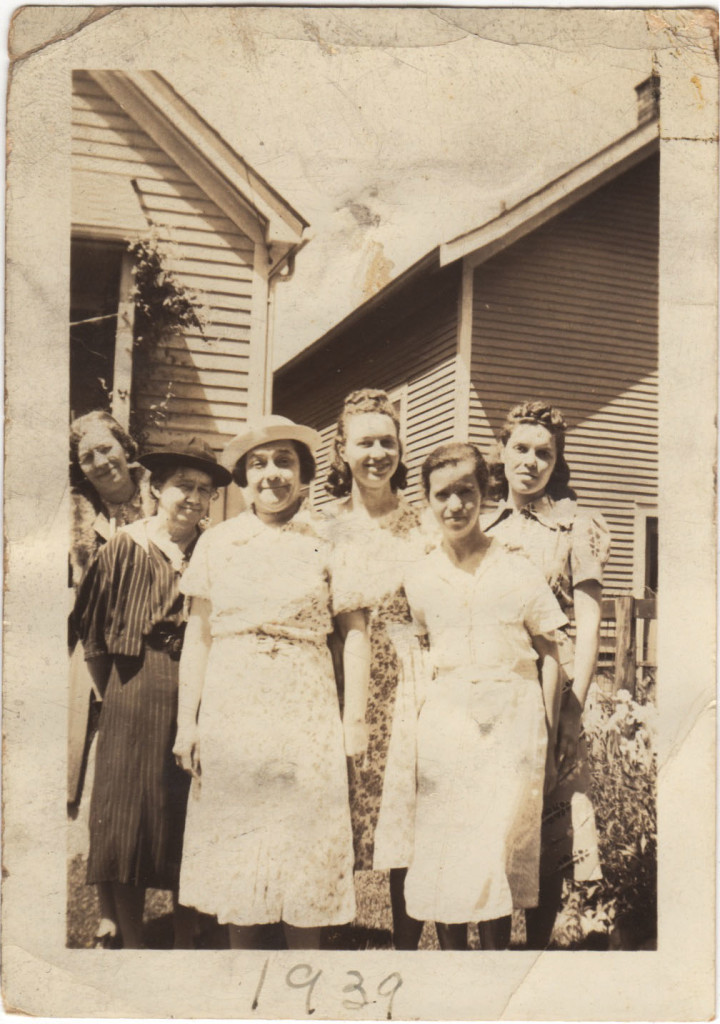
February 12 – Doris’s birthday – 17 today. We had a nice dinner, cake, ice cream and gifts for her from all.
March 12, my birthday, among all a purchase certificate from JL Hudson’s from our daughters and dad
April 3 – Mary Virginia is 20 today. We had nice dinner cake and ice cream and gifts from us all – also Aunt Daisy never forgets with money.
Dad celebrates Christmas day.
Other entries from Fannie’s journal posted in 2010.

This is my tenth A to Z Challenge. My first was in 2013, but I missed 2021. This April I am going through the alphabet using snippets about my family through the generations.

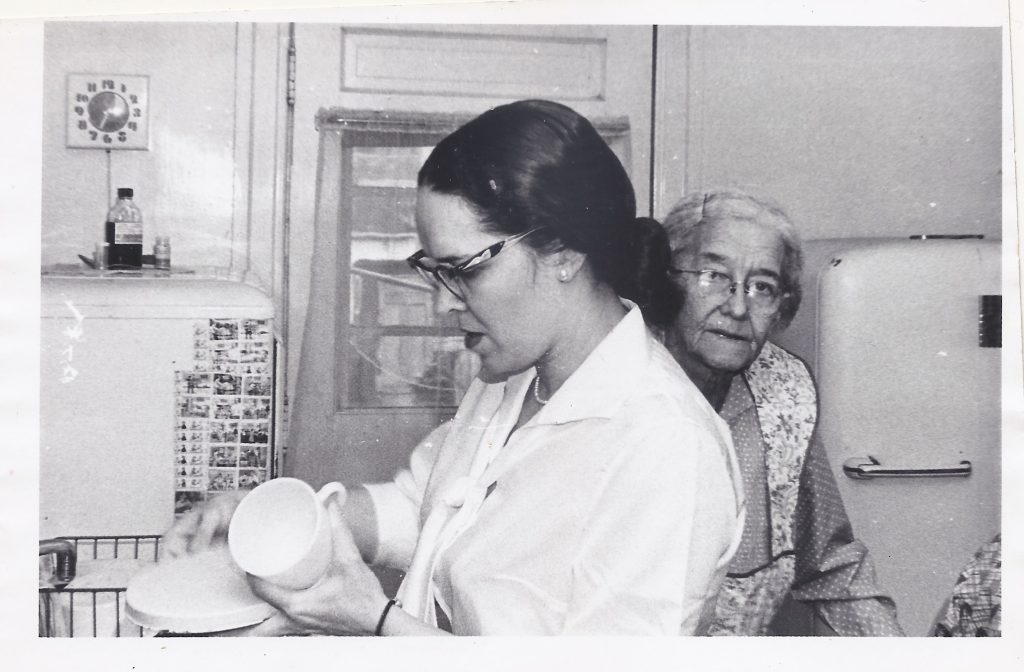
My mother and grandmother in the kitchen doing the dishes and cleaning up after Thanksgiving dinner in 1963. Unlike in the everyday world, my sister and I didn’t help with the dishes at my grandmother’s house. The adults did it all
Below is something I wrote in 2012. Since then I have found the answers to many of the questions I had then. Links are to posts answering some of the questions. But I still wish I had asked.
The generations gathered around my Graham grandparents dining room table in 1963 for Thanksgiving dinner. There was turkey with cornbread dressing cooked by my grandfather. There was white rice, cranberry jelly, green beans, corn pudding and sweet potatoes. There was my grandmother’s finely chopped green salad and her homemade biscuits with butter and with a relish plate holding olives, sweet pickles and carrot sticks.
One thing there wasn’t, was talk about the old days. My grandparents were born in 1888. My grandmother was born Fannie Turner in Lowndes County, Alabama. My grandfather was born Mershell Graham in Elmore County, Alabama. They met and married in Montgomery. My great great Aunt Abbie was born in 1877 in Montgomery, Alabama and was the second to youngest child of Dock and Eliza Allen. My mother told us stories she had heard from her mother, mainly about Dock and Eliza and their children. I remember once my older cousin was trimming Aunt Abbie’s toenails when Aunt Abbie mentioned that she used to trim her grandmother’s toenails when she was a girl. And that her grandmother also had arthritis. And that they called her “The African.”I have always remembered that, but I didn’t ask any follow up questions about her grandmother, Annie Williams who was born a slave and was full grown and the mother of a fully grown woman when she was freed. And Aunt Abbie didn’t say anything else about it.
My grandfather, who we called Poppy, was a mystery. My mother only had little parts of stories she had gotten from her mother, things that just made the mystery deeper in most cases. What were his siblings names and what happened to them? Are the ones I’ve found that I think are his siblings, really his siblings? In 1900, I found these possible siblings living with a man who is listed as their father but has a name not listed on any of their death certificates, was he their father with a different name? And where was he, my grandfather, in 1900? Why wasn’t he there, or anywhere else I can find? Where was their mother? What was the name of the little white girl he was servant of when he was a boy? The one he slept on the floor outside of her bedroom door? The one who changed his name from Michele to Mershell because Michele sounded too “foreign”? How did he learn to read? Did he go to school? Did he know his grandparents and what plantation did his parents come off of? There was a photograph of his sister and her children in the album. I would like to ask him what their names were. Are they the ones I’ve found in the census?
I would like to ask my grandmother some of the same questions about her father’s family. Howard Turner died when she was 4 and her mother moved away from that community and went back to her family in Montgomery. I was able to find her father’s family because I knew his name, his age and the community he came from but I have no stories about his parents and siblings or what plantation they came off of. I only know that his father, Joseph Turner of Hayneville, Lowndes County was a farmer and owned his own land and had given his son some land which he didn’t want him to sell and the two of them argued about it.
When we went by my other grandparent’s house for desert I would ask where my grandfather’s mother, Celia Rice Cleage Sherman is buried. And why my grandmother Pearl thought her grandmother was Cherokee.
Unfortunately, I can’t go back to 1963 and sit around the table and steer the conversation around to who was where and when and how and why. I can only use the information I do have to keep looking and hope that one day some cousins from those mysterious lines will turn up and perhaps have some of the answers to my questions.

This is my tenth A to Z Challenge. My first was in 2013, but I missed 2021. This April I am going through the alphabet using snippets about my family through the generations.
Rev. Horace White was the pastor of Plymouth Congregational Church from 1936 until his death in 1958. Both of my parents were members and met at Plymouth. My father credited Rev. White with turning him to the ministry. I decided to look for information about him and the article below is one that I found. It reminded me of some of my father’s writings.
By Horace White
The Michigan Chronicle
Detroit, Michigan · Saturday, November 03, 1945
It ain’t yet – The Negroes have jumped overboard because one Negro has been assigned to get ready to play baseball in the white organized baseball fraternity. We always jump overboard at the least provocation in such matters. We make too much out of such events in our news. Of course it is an achievement to get such an assignment. But it is not any great step forward yet. The assignment of the young Negro ballplayer has in it only the fact that he is a very promising player.
Negroes are not accepted yet on the basis of their merit. It will be a long time comparatively speaking before we will be so accepted. It is no fault of the Negro players that such is the case – our American race prejudice causes this particular situation as race prejudice causes many other un-American acts on the part of Americans.
It is nothing short of pathetic to see a race of people so eager for acceptance that the least little crumb dropped to them causes so much excitement. Maybe that is the way it has to be. There is one thing sure, about giving so much importance to the ordinary and common place events of our lives, we set our sights lower than we ordinarily would. Young people accept little achievement in terms of something really important. You and I have seen how easily a whole race gets vicarious pleasure and a sense of achievement from the fact that one Negro has been given some ordinary job or position.
Many times young people are given the wrong evaluation of achievement when they see their parents making such a fuss over small things. When small things are assigned to us as a race let’s be big enough with ourselves to accept small things as small things. It is nothing short of weakness on our part when we get and give so much publicity to any little incident of acceptance.
How can we get over this seeking of approval from the majority at almost any cost? This is no easy task. We have been denied and we have looked for our satisfactions from the people who have denied us so very long. We feel sometime that approval from the majority group is worth any effort that we may make.
Of course we can understand why we seek so much approval. The reasons are not far to seek. Any people living as a minority group in all ways. The majority group does its domination through education, social mores and economic controls.
The minority groups usually succumb to these controls of the majority group. One way of succumbing to the controls of the majority is to bite for every sop that the majority group hands out. The assigning of a Negro to a berth in organized baseball is an example of what is meant here. The Negro population has been led to believe that Negroes have gained something by the very fact that the young man has been assigned to play with the Brooklyn Dodgers. Still, nothing has been gained.
The boy is good. It is good business for the team to sign him to play. More than this fact we should as Negroes take the position that the recognition of the abilities of Negro players is long overdue. Therefore, Negroes should not express so much joy over the fact that the very fine young man has been signed. We are glad for him and that is all.
This unusually overrated incident is no different than the “hell” that some Negroes are “raising” over the fact that Jane White is taking the lead in “Strange Fruit.” The protest of Negroes is so silly to say the least. Yes, it is possible for a Negro woman who has gone to college to fall in love with a no-good white man. Negro women who have gone to college fall in love with no-good Negroes. “Strange Fruit” is a real novel.
The protest over a Negro woman playing “Nonnie” in “Strange Fruit” is a sign of our total insecurity. We cannot face a situation without “tears” of wishful thinking. We always try to put our best “foot” forward even to the point of being ridiculous.
Our family life must provide the way for us to escape the basic need for acceptance. Young people must learn how to find inner emotional strength within themselves. Our families must provide a real basis for Negroes to free themselves from a need to seek acceptance from the majority group. We must seek brotherhood. Brotherhood means giving of selves equally. Anything else is subjugation.

This is my tenth A to Z Challenge. My first was in 2013, but I missed 2021. This April I am going through the alphabet using snippets about my family through the generations.
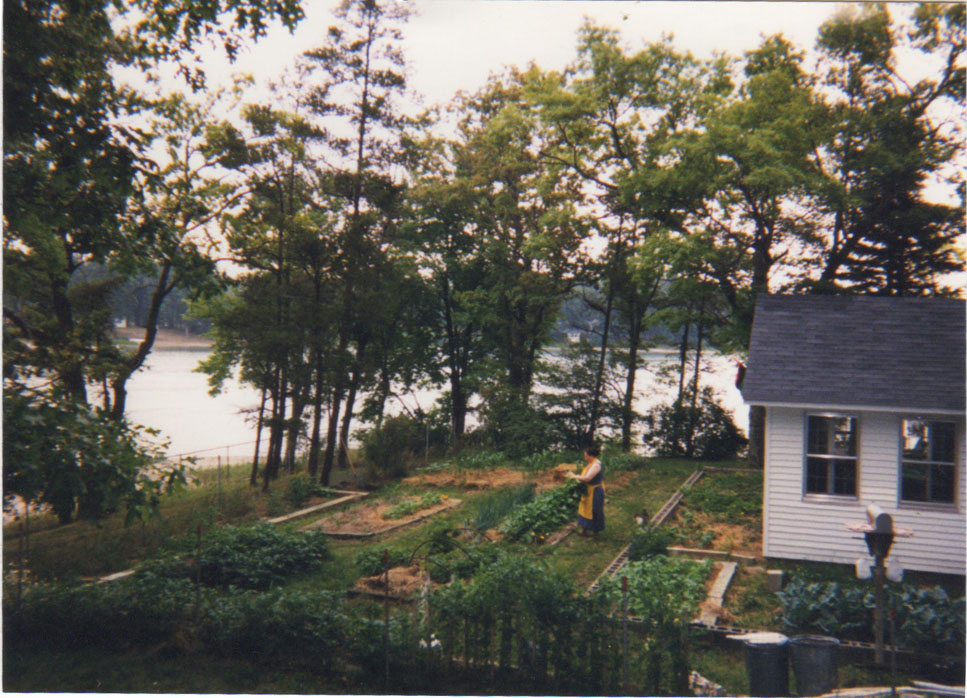
Kristin Cleage
Our garden this year has been great, best I’ve had in years. Jim Tulani, James and Cabral got up a fence in early June that keeps the dogs from rolling around in the beds. Jim brought several pickup loads of horse manure from a local horse owner soon after the fence went up. He also roto-tilled several planting beds that were over grown and made a large double bed for the corn.
I got it planted soon after, before weeds could take over again and mulched everything heavily…the hay was here on time. We got all of this done pretty much before I started working. The beginning of the summer was hot and dry, so I watered. It soon changed to hot and wet, wet, wet. Now it’s cooling off and raining pretty well.
We’ve been eating summer squash, plenty of green beans (freezing some too.), collards, broccoli, swiss chard. The corn is tassling and there’s enough of it this year that you can hear it rustling in the wind. The pumpkins and winter squash may make it before frost if they hurry. Lots of green tomatoes, onions and red beans. The only down side so far is that the beans I planted with the corn (I even let the corn get up good before I planted them this year.) turned out to be bush beans and not Kentucky Wonder climbers. Looks kind of strange having those bush beans growing around the bottom of the corn.
I plan to put in lettuce, mustard, turnip and transplant kale as soon as the beans give out and by putting plastic over the pipes I bent over them, to eat from the garden up until Thanksgiving.
And next year with the fence already up, maybe I’ll really get some plants started and out early and have potatoes. The tomatoes Ayanna started this year look good. I did dream we had a killing frost a few nights ago, but I hope it was just a dream, I mean, it’s only August? No killing frost in August, even in the North woods, right?
The Ruff Draft May/June 1994 page 5
Today I did two G posts, unawares. The other is G- Glimpses in Detroit’s Mirror!
